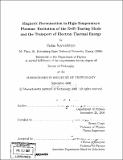Magnetic reconnection in high-temperature plasmas : excitation of the drift-tearing mode and the transport of electron thermal energy
Author(s)
Roytershteyn, Vadim
DownloadFull printable version (3.781Mb)
Other Contributors
Massachusetts Institute of Technology. Dept. of Physics.
Advisor
Bruno Coppi.
Terms of use
Metadata
Show full item recordAbstract
The problem of excitation of the drift-tearing mode (Coppi, 1964) in high-temperature plasmas is considered. Existing theories predict that under the conditions typical of modern toroidal experiments on nuclear fusion, the mode is linearly stable in both collisionless (Coppi et al., 1979), and in a weakly collisional (Antonsen and Drake, 1983) regimes. We propose that the presence of a spectrum of background microscopic modes leads to destabilization of the drift-tearing mode by significantly altering the electron thermal energy transport. Two phenomenological models that illustrate this possibility are considered. In particular, we demonstrate that a localized reduction in parallel electron thermal conductivity, or a localized depression in the electron temperature gradient cause a significant reduction of the mode excitation threshold, as measured by Acrit, the jump of the first derivative of the magnetic field across the reconnection layer. Both experimental observations and theoretical considerations indicate that in the regimes of interest the values of the perpendicular thermal diffusivity D are significantly higher than the corresponding collisional estimates. Therefore the influence of the perpendicular heat flux on the excitation properties of the drift-tearing mode must be analyzed. (cont.) The result is that for D above a certain critical value D, which depends on the parallel thermal diffusivity and parameter re = dlnTe/dlnx, the excitation threshold of the mode is significantly reduced, and can be negative. This indicates the presence of an additional drive for the mode, which has been identified as the perpendicular electron temperature gradient. When D > D, the growth rate of the mode is an increasing function of the parameter qe, which is in contrast to the regime of relatively small or zero perpendicular thermal diffusivity, D < D, where the mode becomes more stable as re is increased. In the collisionless regime the drift-tearing mode is stabilized by the effects of the electron Landau damping, which play a role similar to that of the parallel thermal conductivity in the weakly collisional regime. It is well known that Landau damping can be significantly affected by such effects as spatial and velocity-space diffusion. We consider the influence of the resonance broadening due to particle spatial diffusion on the excitation properties of the drift-tearing mode. Such resonance broadening is found to cause a reduction of the excitation threshold. However, the employed semi-analytical treatment of the problem allows only consideration of relatively small values of the corresponding diffusion coefficient. In this regime the reduction in the excitation threshold is rather small.
Description
Thesis (Ph. D.)--Massachusetts Institute of Technology, Dept. of Physics, February 2007. Includes bibliographical references (leaves 95-100).
Date issued
2007Department
Massachusetts Institute of Technology. Department of PhysicsPublisher
Massachusetts Institute of Technology
Keywords
Physics.